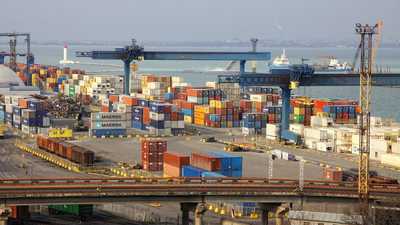| Home | About | Archives | RSS Feed |

The Retired Investor: Crypto Crashes (Again)
 |
While investors focus on the losses that are piling up in the stock market, the cryptocurrency space has suffered far more. The bears say it has further to go, but that may depend on what happens to stocks.
Bitcoin, the grandaddy of crypto currencies, is trading around $36,900 per coin as of Jan. 27, 2022. It has suffered a 50 percent decline since its record high in November 2021. Ethereum, the second most popular coin, has dropped from almost $5,000 to $2,498. In total, the combined crypto market has lost $1.4 trillion over the past week.
At one time, crypto speculators argued that coins like Bitcoin danced to their own music and were uncorrelated with the boring stock and bond markets. Others like Nayib Bukele, the President of El Salvador, made Bitcoin legal tender in his country. Some professional sports stars announced their desire to be compensated in crypto, and even the Mayor of New York City Eric Adams said he would be converting his first three paychecks into Bitcoin and Ethereum.
As more celebrities (like Matt Damon) and companies expressed willingness to accept payment in crypto currencies, it seemed crypto's extreme volatility might be a thing of the past. More and more retail and then institutional players began investing in crypto currencies. Company managements from Tesla's Elon Musk to MicroStrategy's Michael Saylor expressed confidence in the viability of this market. That may have been true, but underneath the hype things have changed. As many traditional investors began to consider electronic currencies, the currency market changed.
That was good news at first, as crypto bulls argued that "crypto had finally come of age." But traditional investors soon began to consider electronic currencies as just another risk asset. As a result, over the last two years, the prices of coins such as Bitcoin and Ethereum have increasingly become linked to the movement of stock prices.
In tougher markets, like we have been experiencing since the new year, investors tend to sell riskier assets like commodities, stocks and now crypto. So, who has been selling? Retail investors for the most part, according to reports from the Wall Street Journal. That makes some sense, since crypto currencies, (in hindsight) were a main beneficiary during the pandemic of the wave of government stimulus money and extended unemployment checks that found its way into many American pockets.
As in every market, as certain coins hit historical highs back in November 2021, many retail buyers poured money into the coin market at its peak. Now, these investors (called weak hands by the crypto faithful) are heading for the exits all at once, while institutional investors, inured to the ups and downs of the market, hold steady. Some believe that there may be a political angle to this sell-off as well.
The government continues to monitor and study ways of reigning in some of the excesses of this crypto currency market. There have been recent reports in the media that the Biden Administration is gearing up to issue a cryptocurrency executive order asking federal agencies to determine crypto risks and opportunities. The specter of a flurry of government regulations dealing with everything from national security to oversight on transactions, products, and platforms has investors worried.
As the crypto market matures, some misconceptions are becoming apparent. Clearly, the idea that crypto currencies could act as an inflation hedge has now proven to be a myth. Nor do they act as a safe haven (like the U.S. dollar) in times of geopolitical uncertainty. Volatility, however, seems to a distinguishing and enduring feature.
The fact is that this marks the eighth time that Bitcoin has fallen 50 percent or more since its inception in 2009. In each case, the price has risen to a higher price, although there have been times when it has traded sideways for months to years. It is not, as many believe, a get-rich-quick scheme, or sure-fire way to riches. Strip out the mystique — what it ultimately could be, or should be — and what do you get? Crypto currencies are simply another class of risk assets. and What's wrong with that?
Bill Schmick is the founding partner of Onota Partners, Inc., in the Berkshires. His forecasts and opinions are purely his own and do not necessarily represent the views of Onota Partners Inc. (OPI). None of his commentary is or should be considered investment advice. Direct your inquiries to Bill at 1-413-347-2401 or email him at bill@schmicksretiredinvestor.com.
The Retired Investor: A New Female Fed
 |
| Lisa D. Cook, left, and Sarah Bloom Raskin have been nominated to join Michele Bowman and Lael Brainard to the Federal Reserve Bank Board, making women the majority for the first time. |
Just before Martin Luther King Jr. Day, President Biden announced three new nominations to the Federal Reserve Bank Board, two of whom are women. If the U.S. Senate approves, women would then account for most of the Federal Reserve Bank's seven-member board.
Lisa Cook and Sarah Bloom Raskin, if confirmed, would join Lael Brainard, who President Biden picked as vice chair, and Michelle Bowman, who is already a board member. In addition, Lisa Cook would be the first Black woman on the board. Women are still in the minority, however, if you include all the Federal Reserve Bank's regional presidents, but the board is where the voting power resides. All-in-all, I say hip-hip hurrah for women!
Don't get the idea that women have been excluded from Fed membership in the past. Plenty of women have served on the central bank's policy-making team and Janet Yellen, the present U.S. Secretary of the Treasury, held the top spot between 2014 to 2018. Secretary Yellen, in commenting about the president's picks, remarked that the U.S. economy has "never really worked" for Black Americans, "or really for any American of color."
In my opinion, the proposed composition of the board would better reflect the actual population of the United States. Women, for example, account for 80 percent of all consumer spending decisions in the U.S., including 93 percent of the decisions on food purchases and 65 percent of automobile purchases. They are the ones who notice inflation, price changes, the cost of day care, and how badly rising prices can stretch the family budget.
If we do see a new composition of the Fed board, don't expect any big changes to monetary policy any time soon. The Fed is still bound and determined to quell inflation, even if that means tighter monetary policy during the next several months. However, the two women nominees for board governors, plus Phillip Jefferson, the third of President Biden's nominations, are expected to place their focus on a healthy labor market.
All three would have a permanent vote on monetary policy (unlike regional Fed presidents who rotate) and their influence over the economy could outlast the administration that appoints them. All three nominees have in the past articulated their commitment to assist workers and to forge greater racial equality. In order to do so, I am betting that the three would be reluctant to push interest rates higher once the inflation scare is resolved.
In the case of Sarah Bloom Raskin, who would be the Fed's top regulator, the Fed's growing focus on climate change could also be strengthened. Raskin, who served as a Fed governor from 2010 to 2014, has advocated the need for financial regulators to prevent climate change from becoming a systemic risk to the banking system.
She sees a need for financial regulatory agencies, like the Fed, to go beyond analysis and planning and face the danger of climate change head on. She argues that the Fed and others should be assisting firms in addressing the risks of climate change, and also play an active role in reducing emissions.
Getting past the U.S. Senate will not be an easy task for the president's picks. The top Republican on the Senate banking Committee, Pat Toomey, has already expressed ‘serious concerns' about the Raskin nomination. It remains to be seen what opposition forms in the coming days over President Biden's remaining nominees.
One can be sure, however, that if by some miracle all three successfully survive the U.S. Senate gauntlet, the future Fed will be more explicitly pro-worker and probably far more attune to the country's needs than ever before.
Bill Schmick is the founding partner of Onota Partners, Inc., in the Berkshires. His forecasts and opinions are purely his own and do not necessarily represent the views of Onota Partners Inc. (OPI). None of his commentary is or should be considered investment advice. Direct your inquiries to Bill at 1-413-347-2401 or email him at bill@schmicksretiredinvestor.com.
The Retired Investor: No-Shows Threaten Economy
 |
Last week, economists calculated that almost 5 million workers failed to show up at their jobs. Given the present upsurge in cases of the Omnicom variant, that should come as no surprise. However, it clearly has Wall Street economists reducing their estimates of first quarter 2022 GDP.
Slower economic growth normally has a negative impact on everything from the stock and bond markets, interest rates and employment. How this will ultimately affect the economy in the months ahead is a question worrying every trader and portfolio manager in the financial markets.
The first warning sign that this wave of coronavirus infection was impacting business came during the holidays. Thousands of flights, we thought, were canceled due to weather-related concerns and maybe some no shows due to the holidays. It soon became apparent that employees from pilots to baggage handlers and everyone in between were getting sick, or forced into quarantine, by the omicron variant.
Since then, a wave of omicron infections has decimated the working forces of supermarkets, shipping ports, transportation hubs, and a variety of factories and food processors throughout the country. I am starting to notice this personally. Just Wednesday, as I stood in a long line at my local supermarket, I noticed the lines seemed to be getting longer, even though holiday shopping is long over.
First, my concern was simply maintaining the 6 feet of spacing since most shoppers were ignoring the footprint markers behind me. Masked, gloved, and behind a plexiglass partition, my turn finally came. I asked the clerk why the lines were so long.
"A lot of people are out sick," said the weary, masked clerk. "So why not hire more people?" I asked. In response, she just laughed, nodding towards the "help wanted" signs behind her. I noticed her nose was poking out from the top of her mask. I held my breath.
The clerk also lamented that her schedule was in chaos, since no one knew which employees would be sent home tomorrow to quarantine, or who would be sick and how long it would be until they returned. "It's the same kind of thing you normally see when there is a big snowstorm. Some make it in, most don't."
And what is happening stateside is also developing throughout the globe. Europe has been struggling with the same issues. China, due to their strict isolation policies, has been managing somewhat better than most countries — until recently. This week, China's Zhejiang Province, home to one of the country's key ports, has suspended or greatly reduced the transportation of manufactured goods and commodities into Ningbo port, thanks to an outbreak of omicron last week.
Unfortunately, Ningbo is one of a handful of the world's largest container ports and an integral link in the world's supply chain connecting producers in East China with buyers of everything from automobiles, electronics, semiconductors, heavy equipment, machines, clothes and even toys. A second major port city, Dalian, a city of 7 million, announced its first cases of omicron Jan. 12, threatening the closure of its port. As a result, ships are heading for Shanghai's huge container port, which is causing congestion and delaying shipments by at least a week.
In August 2021, the port was shut down for a couple of weeks because of COVID-19. Analysts estimated it cost the world about $4 billion a week during that shut down. As it stands, global shipping ports have been working to reduce the congestion that has stranded an armada of container ships along their shores. Here in the U.S., the government has made efforts to relieve the port congestion in Los Angeles. On the East Coast, the New Jersey and New York ports have until recently managed to keep up with port congestion. However, omicron is steadily reducing the number of longshoreman available. As a result, the line of ships building off the coast of Long Island is increasing daily.
During the course of the last week, several economists have downgraded their forecasts for the first quarter 2022 GDP. Some are simply postponing growth, pushing it out to the second quarter. Economists are arguing that while Omicron may hurt growth in the short-term, the variant will flare out, and growth will resume in time to show higher by May or June. Let's hope they are right.
Bill Schmick is the founding partner of Onota Partners, Inc., in the Berkshires. His forecasts and opinions are purely his own and do not necessarily represent the views of Onota Partners Inc. (OPI). None of his commentary is or should be considered investment advice. Direct your inquiries to Bill at 1-413-347-2401 or email him at bill@schmicksretiredinvestor.com.
The Retired Investor: My Dog's Medical Bills Are Higher Than Mine
 |
On the surface, it was a good year if you were in the veterinary business. Year-over-year sales grew by 9.1 percent, while patient visits increased by 3 percent. For pet owners, however, not so much.
Owners found that the cost of keeping their pets healthy jumped by about 10 percent. Some of that price increase was due to higher fees, but consumers were also purchasing more products and services.
My chocolate Labrador Retriever, Titus, is now 13 years old. The rule of thumb: every year of a dog's life equals seven years of my life. That would put Titus' age at 91, versus my age of 73. I won't detail all his health ailments, suffice it to say that he is in the vet's office just about every other week. Those visits last for 30-60 minutes and we usually leave with medications. The cost fluctuates between $175 and $375 per visit (not counting the meds). In contrast, I saw my doctor twice last year and the one medication I take is free.
Just like human medicine, veterinary medicine is experiencing new advances and frequent discoveries. Universities and pharmaceutical companies worldwide are stepping up their research, conducting quality trials, and achieving breakthroughs that are providing an entire range of modern medicines. As such, surgical procedures are now commonplace. Conditions, which in the past would spell end-of -life decisions by owners, are now treatable.
Pet cancer treatments, for example, were practically unheard of twenty years ago. Today, the Veterinary Cancer Society estimates one in four dogs will develop cancer (and almost 50 percent of dogs over the age of 10). As a result, more and more vets are treating cancer, but at a cost.
Specialist visits to confirm cancer can run upwards of $1,500. Treatments are expensive — chemotherapy ($200-$5,000), radiation ($2,000-$6,000), drugs ($50+ per month). A cancerous pet can set you back $10,000 or more. And unfortunately, more and more pets are showing up with cancer.
To make matters worse, there is no such thing as Medicare for your dog. That means there is no government program to reimburse the veterinarian cancer hospitals, so they pass the full costs on to the pet owner.
What about pet insurance, you may ask? Unfortunately, many new pet owners don't feel the need to buy insurance for their pet until after it is too late. But even if you have pet insurance, most policies only cover half the cost, and typically pet insurance requires that you pay upfront.
Titus doesn't have cancer, thank goodness, but he did have a herniated disc where his tail meets his spine a few years back.
That little operation cost $15,000 -- about the price of a European vacation (which we decided to forgo in favor of the operation). But as Titus aged, his hind quarters are giving out, while the arthritis in his shoulders continues to worsen. As a result, his prescription medicines are crowding out my own in the medicine cabinet and there is no Prescription D plan to take care of the costs. The most we can look forward to is more of the same. Bottom line — we love him — so it's worth it to us.
But don't think that your local vet is minting millions from your pet's misfortunes. If all they cared about was money, they would have entered another field like dentistry or human medicine. There aren't that many vet schools in the U.S. and all of them are highly competitive. The cost and duration of the education is similar to the cost of a human medical school. But the average salary of veterinarians is less than half of what medical doctors pull in. New vets have low starting salaries and high student debt payments as well.
Supplies, equipment, and facility costs are equivalent to human medicine expenses. Staffing costs are lower, but a highly skilled and well-trained staff still costs money, especially in an environment of labor shortages and high turnover. In addition, the stress and pressure caused by the pandemic has taken its toll on vets. Omicron just increases those challenges. In the meantime, the increase in demand for veterinary care has exploded.
All in all, be grateful that you have a vet to go to when needed. Expect your vet bills to continue to increase. The best thing you can do is begin to practice preventive care. Regular vet care is important, even when nothing is going on. Vaccines, spaying and neutering, dental cleanings, flea and heartworm prevention, bloodwork and yearly exams are critical to keeping the big bills in check.
Bill Schmick is the founding partner of Onota Partners, Inc., in the Berkshires. His forecasts and opinions are purely his own and do not necessarily represent the views of Onota Partners Inc. (OPI). None of his commentary is or should be considered investment advice. Direct your inquiries to Bill at 1-413-347-2401 or email him at bill@schmicksretiredinvestor.com.
The Retired Investor: Climate Change Is Costing Billions
 |
In 2021, worldwide, the costs of the ten worst disasters caused by climate change totaled more than $170 billion. It was the fourth time in the last five years that we have suffered that level of damages. Scientists expect next year to be even worse.
Insurance companies, like Zurich-based Swiss Re, bear the brunt of the costs of extreme weather. During the last decade, losses have been rising 5-6 percent per year, according to Swiss Re's recent analysis. They expect at least one $10 billion catastrophe, such as severe flooding, a winter storm, or a massive wildfire will be part of the new normal in weather changes.
What is worse, more than ever before, extreme weather events are striking densely populated areas. That is one reason why these disasters are so costly. As we continue to spew greenhouse gases into the air, as global temperatures continue to climb, scientists believe that future annual insurance losses will continue to far exceed the $100 billion mark.
Hurricane Ida, according to a U.K.-based, non-profit organization called Christian Aid, took first place in U.S. damages in 2021. The August storm made landfall in Louisiana as a Category 4, costing $65 billion in damages as it made its way across the Eastern part of the country. July's Western European floods came in second with a price tag of $43 billion. In February 2021, the winter storm that paralyzed Texas, damaging the state's electrical grid, racked up $23 billion in losses.
While Louisiana was dealing with Hurricane Ida, China's Henan Province was hit by massive flooding, accounting for $17.6 billion in destruction. British Columbia saw record-setting rainfall in November 2021, which cost Canada $7.5 billion.
Some of the other disasters that didn't make the grade, but cost billions of dollars, nonetheless, were Cyclone Yaws in India and Bangladesh, Australian flooding in March that displaced 18,000 people and cost $2.1 billion in damages, the Parana River drought in Latin America, which impacted jobs and lives in Brazil, Argentina, and Paraguay. I could go on and on.
But by no means does this partial list of climate disasters accurately reflect the total cost of climate change in 2021. These damage assessments were completed, for example, prior to the Dec. 11, 2021, six-state trail of devastation caused by more than 40 tornadoes in the U.S. Costs of that catastrophe are estimated to total $3.7 billion. It will be months before we know the true costs of climate change in 2021.
Unfortunately, most experts tend to focus on the financial costs to wealthier countries, which typically have higher property values. It is also in developed nations that insurance companies conduct most of their business. Many of this year's worst weather events have occurred in poorer nations, which have contributed far less to climate change, but have suffered disproportionately more in lives lost and in suffering.
In the beginning of 2021, 17 scientists in Australia, Mexico, and the U.S. co-authored a perspective paper in the journal "Frontiers in Conservation Science." They concluded that much of humankind was in a state of denial when it came to climate change. I happen to agree with that view. As we draw closer to a "collapse in civilization as we know it," governments and political parties all but sit on their hands as the world burns.
For example, President Biden's infrastructure bill earmarked $47 billion to help communities to prepare for a new age of climate catastrophes. That was far less than the $88 billion in costs of just two of the nation's extreme weather events this year. And yet members of both political parties fought tooth and nail to reduce that amount!
The worldwide pandemic is small potatoes, in my opinion, compared to the era of devastation that we are now entering. Get real, people. The loss of biodiversity, climate disruption, unbridled human consumption, and exploding population growth, if left unaddressed, will make the lives we live today ecologically unsustainable.
While we may all be shocked, (even worried for a day or two) by 40 tornadoes overnight in six states, imagine what will happen when downtown Manhattan, Chicago, or Boston experience similar events. Unfortunately, by then it will be too little too late.
Bill Schmick is the founding partner of Onota Partners, Inc., in the Berkshires. His forecasts and opinions are purely his own and do not necessarily represent the views of Onota Partners Inc. (OPI). None of his commentary is or should be considered investment advice. Direct your inquiries to Bill at 1-413-347-2401 or email him at bill@schmicksretiredinvestor.com.

